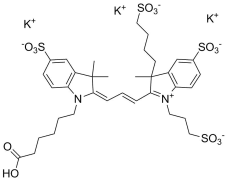6-Carboxy-H2DCFDA also known as (6-carboxy-2′,7′-dichlorodihydrofluorescein) is a chemically reduced, acetylated form of fluorescein that is primarily used as an indicator of reactive oxygen species (ROS) in living cells. It is a non-fluorescent compound that begins to fluoresce after the acetyl group is cleaved by cellular esterases and oxidized by intracellular reactive oxygen species. The resulting 6-carboxy-2′,7′-dichlorofluorescein fluoresces brightly in the green channel (absorption maximum at 511 nm, emission maximum at 533 nm) and can be used for flow cytometry, plate reading, etc. Detection by various methods, or fluorescence microscopy. The acetyl group in 6-carboxy-H2DCFDA increases its lipophilicity and improves the permeability of the indicator across the cell membrane. After deacetylation by cellular esterases, the compound acquires an electrical charge, allowing it to remain within the cell. This carboxylated H2DCFDA analog has two additional negative charges that prevent it from leaking out of the cell.
Recommendations for using reagents:
Use freshly prepared reagent solutions (working solutions are not suitable for long-term storage because reagents will gradually oxidize).
Select optimal reagent working concentrations and incubation times for reagent deacetylation and oxidation for a specific cell line and assay conditions. If there is no recommended protocol for a specific cell line, start with a concentration of 1 to 10 μM and incubate for 30 min.
Do not incubate the dye with cells in the presence of serum, as it contains enzymes that cleave H2DCFDA.
AxisPharm offers 5000+ PEG Linkers with high purity. Different kinds of PEG Reagents may be available by custom synthesis.






